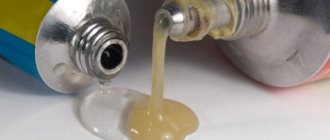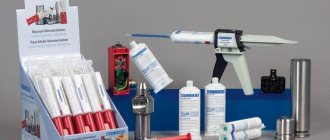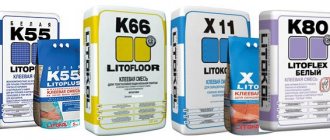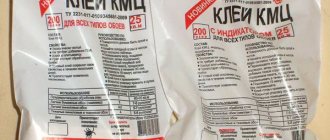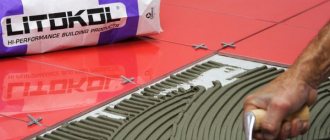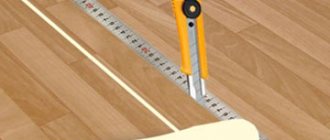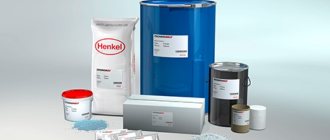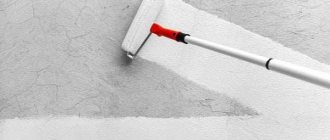According to building codes, any linoleum must be laid using the adhesive method - solid or edge. Depending on the type of coating and thickness, select the appropriate adhesive for linoleum to achieve the desired result. If the glue is chosen correctly, there will be no waves or bubbles, the edges will not beaded (raised), and there will be no traces of feet or furniture.
In order for you to make the right decision, we have prepared a rating of adhesive compositions for linoleum for various purposes. Also in the article you will learn how to glue linoleum to the floor, whether it is necessary to glue it at all and what is the glue consumption per sq.m.
| Category | Name | Price, kg/rub. | brief information |
| The best adhesive for linoleum on concrete floors | Axton | 1,3/193 | Universal. Suitable for linoleum, carpet. Apply to any substrate, including porous ones, with a roller or spatula. Has good frost resistance. Consumption 0.2 kg/m2. |
| TYTAN Professional | 14/2100 | One-component water-dispersion adhesive. Suitable for absorbent building substrates such as concrete, plasterboard and wood. | |
| Homakoll 208 | 14/2730 | Suitable for household and commercial linoleum, carpet, cork, and any other artificial floor coverings for concrete, cement screed, wood, chipboard, fiberboard. Consumption 300-500 g/m2. | |
| The best adhesive for linoleum on wood floors | CS "Optimist" | 18/474 | Ready-made heat-resistant composition based on liquid glass, with the addition of latex and thermoplastic polymers. The structure is viscous, seals cracks and cracks. The coating does not bubble. |
| TEX KS Construction | 18/510 | Universal. Heat resistant – up to 400°C. High adhesion to complex materials - concrete, glass, wood and even tiles. | |
| EXPERT Bustilat | 1,3/104 | For all artificial coverings on concrete, wooden floors, chipboard, OSB. Consumption per meter is 500-600 g with continuous application, dries within 24 hours at a temperature of 20 °C. | |
| The best acrylate adhesive for linoleum and seams | Homakoll 248 | 1/127 | Acrylic resin based mixture. It is characterized by high adhesion and viscosity, which ensures excellent adhesion of the coating to the floor. For semi-commercial PVC covering. Consumption 300 – 500 g/m2. |
| Polynomial 101 | 18/1630 | For all floor coverings on PVC, jute, foam base. Apply to vapor- and water-permeable substrates. Consumption 300-500 g/sq.m. | |
| Krass | 14/1820 | Suitable for household and semi-commercial PVC coverings. Withstands 10 freezing temperatures down to -40°C. Does not shrink, does not deform. | |
| Best Adhesive for Commercial Linoleum | Forbo 522 Eurosafe Star Tack | 13/3100 | High adhesive power, easy to apply, solvent-free. |
| NORME COLOR PROFI | 14/2100 | Provides high shear and peel strength of the adhesive bond. Does not contain volatile solvents. It is not pressed through by heavy objects and under prolonged load. | |
| Thomsit L 240 D/14 | Suitable for linoleum up to 2.5-4 mm thick. Does not shrink. Suitable for heated floors. Withstands point loads (from furniture on casters). Maximum 5 cycles of freezing down to -40°C. | ||
| Adhesive for linoleum cold welding | Werner Müller Tarkett | 0,044/480 | The adhesive composition for welding type “A” linoleum contains a large percentage of solvent. 44 grams is enough for 20 meters of seams, making them monolithic. |
| SINTEX H-44 | 0,1/230 | For cold joining of seams. Forms an invisible film, prevents shrinkage and beading of seams in the joint area. | |
| Economy | 0,05/150 | For butt gluing linoleum. The kit includes a special nozzle that is convenient for applying to the edges. |
Features of gluing linoleum
This results in a monolithic coating, which provides a number of advantages:
- Just lying linoleum, after some time it can go in waves. Deformation occurs in any size room. When using glue, such deformation will not occur;
- When gluing, depressions from furniture legs do not appear on the surface;
- There is no formation of cracks. The edges do not curl. The floor covering has a neat appearance for a long time;
- When gluing, the service life increases significantly.
With all the positive properties, there are several disadvantages:
- Increased labor intensity;
- Difficulty in dismantling the coating.
Useful tips
Due to the fact that the construction market offers a huge selection of adhesives and types of linoleum, you should take into account some of the nuances of laying such floor coverings in order to do everything correctly:
- Whether linoleum needs to be glued depends on the area of the room. In a room less than four square meters there is no need to do this.
- Before applying glue, the floor surface must be leveled, thoroughly cleaned and degreased. The highest quality gluing will be to a porous base. For such a surface, even an inexpensive composition is suitable, which will attach well to the foam, fabric or pile base of the material.
- Flooring made from natural fibers is best secured with a compound that contains a minimum of moisture. This is explained by the fact that during the gluing process the floor covering will absorb too much glue, and this will cause its deformation.
- Natural-based adhesives are ideal for fixing PVC linoleum. But PVC glue does not combine very well with natural coatings due to its low adhesive properties. If you do not take this feature into account, this will lead to a transformation of the structure of linoleum.
- For coatings made from natural fibers, special compositions are produced that contain very little water, which prevents deterioration in the appearance and changes in the structure of the expensive coating.
- Water-dispersed adhesives must be kept for some time so that the substances included in them are activated. If such glue is used, then one of the surfaces to be joined must absorb water well. For this reason, it is advisable to attach PVC linoleum only to a wooden floor or screed.
- On surfaces previously coated with a primer, you cannot use water-dispersive compositions due to the fact that the water will have nowhere to go and there will simply be no gluing.
- Be sure to follow the manufacturer's recommendations regarding glue consumption, especially if it is PVA. The composition applied in excess of the norm will not have time to dry, as a result of which air pockets will form under the coating and it will go in “waves”.
- For residential premises, the best option is acrylic compositions. They do not have an unpleasant odor and are non-toxic.
- Regardless of the type of composition, it should be applied to both surfaces to be joined. Before gluing, you need to leave the glue for a while to dry. Surfaces must be fastened under pressure; this will prevent kinks and unevenness on the surface of the floor covering.
- For installation over large areas, special mastic is perfect.
- You should not use polyurethane or epoxy glue for installation, although they will ensure the best quality connection between the surfaces. Such compounds are toxic and after completion of work a pungent odor will be felt in the room for a long time.
Linoleum in the interior
If you plan to install a “warm floor” in the room, then the glue must be selected with special care. This is explained by the fact that many of the compounds intended for fixing linoleum, even when heated to +30 ° C, begin to release toxic substances. This is unacceptable for residential premises.
At the beginning of 2000, self-adhesive linoleum in the form of tiles became especially popular. This material is convenient to store and lay; there is no need to buy glue, since it is already applied to one of the sides. One damaged tile can easily be replaced with a new one; such building material can be attached to the wall. Disadvantages include high cost and short service life. Self-adhesive tiles cannot be used with a “warm floor” system, or on a balcony or unheated cottage.
Gluing linoleum to concrete
Before starting work, thoroughly rinse the floor surface.
- Before installation, the floor must be completely dry and the baseboard must be removed.
- The final layer of concrete floor must be sanded and cracks filled with putty.
- The gluing area must be degreased and a primer must be applied.
- We leave a gap of up to 0.5 centimeters between the wall and the linoleum.
- Apply glue using a spatula in a thin layer.
- Following the instructions on the glue packaging, sometimes you can use a grid rather than a continuous layer.
The gluing process takes about a day.
Do I need to glue the joints?
The consumer wants to see a monolithic floor covering, which is achieved by purchasing wide sheets up to 4 meters or by fitting and laying narrower strips up to 1.5 meters end-to-end.
Careful gluing to the base allows you to hide the alignment lines of the stripes and make them almost invisible. Practice shows that without treating the joints, contaminants gradually accumulate, affecting the condition of the seam, its deformation and general appearance. To prevent premature clogging and moisture from entering the cracks, additional treatment is needed, despite the seemingly tight connection.
For joining very dense materials or making artistic applications, a linoleum gluing machine is used.
Hot welding technology is available to professionals. To carry out the work, a special gun for gluing linoleum has been developed. Large production premises require the invitation of a master and the availability of equipment.
In domestic conditions, a special glue is convenient for gluing linoleum joints, which will hide the seam, firmly solder the sheets with a colorless compound and protect it from wear. High-quality sealing of a joint is completely invisible to the eye and can only be determined by careful examination of the coating.
Features of gluing to a wooden floor
It is recommended to purchase flooring according to the size of the room. This will avoid making unnecessary seams. Immediately before gluing, it is necessary to trim the linoleum around the perimeter of the room, taking into account all the architectural features.
- The floor must be clean, dry and perfectly level.
- Spread the glue evenly with a spatula, first on the floor and then on the linoleum base.
- If gluing is to be done end-to-end, add additional adhesive tape to the seam.
The procedure for gluing linoleum is similar to the same process for concrete. No matter how carefully you try, glue may accidentally end up on the surface.
If it has time, it will dry out and be difficult to remove. A fresh stain can be easily removed with a soap solution.
No. 5. Types and technologies of gluing
After you have decided on the choice of linoleum and the adhesive that is suitable for it in all respects, it is important to understand what type of gluing and how you will have to do it, especially if you plan to carry out all the work yourself, without special or sufficient skills.
Gluing joints
Features of cold welding
This method is best suited for working with household and semi-commercial linoleum, and is performed in the following sequence:
- lay the coating on the base and gluing it;
- Glue masking tape to the joints, cutting it along the seam;
- squeeze the glue from the tube into the groove, distributing it evenly along the entire length;
- After drying, remove the masking tape and carefully remove the excess.
Laying seams
When laying linoleum with a pattern, take into account that the seams will be located parallel to the rays of light incidence. This way we practically visually remove the seams.
The possibility of using modern technologies, in which the edges of surfaces are melted and soldered using special glue. This method is called cold welding.
No. 4. Reduced possibility of deformation
In order to increase adhesion and reduce the risk of bubbles, waves and other unwanted surface distortions, after gluing the entire area of linoleum is strongly recommended to be rolled with a roller. Another reason for this action may be such an important point as getting rid of possible formation of air bubbles under the material, which can often be observed when working with film gluing.
Choice
The adhesive should be selected taking into account the type of subflooring. Surfaces can be:
Absorbent, which absorbs well. These include concrete or wood flooring. It is customary to use a dispersion type of glue. In terms of safety precautions when using this type of glue, the following precautions apply:
- Mandatory ventilation of the room;
- Use of protective equipment such as gloves, masks.
Non-absorbent ones are facing tiles, marble or granite.
The right choice guarantees quality and extends the life of the floor covering.
To calculate the required volume of adhesive per room area, it is better to use material consumption calculators according to the technical instructions on the glue packaging. The consumption of dispersion glue is approximately 300 grams per meter. Reaction glue costs about 400-500 grams per meter.
